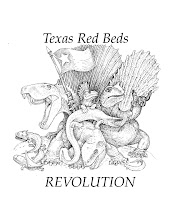These are called trace fossils. Examples we've found locally include footprints, trackways (a series of footprints), burrows and
coprolites. Finding any of these can tell you where animals live on a site, even if you don't find their bones. These fossils are often trickier to spot - but once you've gotten the hang of it, you start to see them everywhere.
So, when is nothing actually something?
In the
Permian, burrows were the holes that animals dug to live in. After death, these holes filled in, and due to their chemical makeup, became encrusted in colliche (a substance that normally covers fossils and is removed to expose them). At this point, the surrounding rock is now softer than the filled-in burrow. When the surface erodes - as it is doing at the Museum's site - all or part of this cast of the hole becomes exposed. What you see on the surface are hundreds or thousands of roughly cylindrical colliche fragments that show you the shape of these animals' burrows. We have found some that represent a hole large enough for a medium-sized dog to crawl in - and some that are small enough for an ant.
 A student in Kim Beck's science class at Seymour High School looks at a possible burrow found at the Seymour site. David visited the classes yesterday to talk about local geology and fossils.
A student in Kim Beck's science class at Seymour High School looks at a possible burrow found at the Seymour site. David visited the classes yesterday to talk about local geology and fossils.
We are not always sure what animal made the burrow -so we take it back to the
Museum, research what other paleontologists have found and compare it to figure out the answer.
Hitting a Home Run
Finding and looking at burrows can seem tedious - especially when all the other team members are
excavating beautiful bones and teeth, and all you've picked up is a funny-shaped rock - but every now and then you'll find a burrow with bones in it. This is a home run - it means you are looking at an animal's house - and they are still at home. Because they died inside their burrow, and were thus protected from the elements, you've got a complete, articulated skeleton.
Previously, we've found 6 complete animals and a larger number of partial animals in burrows. They are the remains of the
Lysorophus, a smallish amphibian that resembles a modern
siren. In response to the drying climate of the Permian, these animals burrowed into the mud to stay moist and waited for the rains to return. They never did, and these burrows became their graves.
You be the judge.
Trace fossils are subtle and paleontologists will sometimes disagree as to exactly what they represent. Case in point - this fossil was found in a spoil pile from the 1917 excavation by the Sternbergs, who either missed it, or weren't interested in collecting it.
 What in this picture piqued David's attention? His possible coprolite is the larger, tear-shaped object in the lower lefthand corner.
What in this picture piqued David's attention? His possible coprolite is the larger, tear-shaped object in the lower lefthand corner.
I suspect it is a world class shark coprolite or a very unusual burrow - my irascible colleague feels it is only an unusual rock. We've got a wager on it - if it turns out to be a coprolite, he's offered to eat it, and I've matched him by saying I will if it turns out to be nothing. We won't be able to settle this dispute in the field - we'll have to wait until we get back to Houston. Stay tuned to see what happens. We should know in about a week.
(David also explains the process of plaster jacketing - which the team is working on today - here. We'll have photos and videos of the process posted later today.)
 These arthropod tracks show the path of a tiny creature (probably something like a crayfish) crawling on the bottom of the ocean millions of years ago. The animal itself is long gone - but thanks to his footprints, we know he was here. Look at the way these tracks have a staircase pattern - what could have caused this?
These arthropod tracks show the path of a tiny creature (probably something like a crayfish) crawling on the bottom of the ocean millions of years ago. The animal itself is long gone - but thanks to his footprints, we know he was here. Look at the way these tracks have a staircase pattern - what could have caused this? A student in Kim Beck's science class at Seymour High School looks at a possible burrow found at the Seymour site. David visited the classes yesterday to talk about local geology and fossils.
A student in Kim Beck's science class at Seymour High School looks at a possible burrow found at the Seymour site. David visited the classes yesterday to talk about local geology and fossils. What in this picture piqued David's attention? His possible coprolite is the larger, tear-shaped object in the lower lefthand corner.
What in this picture piqued David's attention? His possible coprolite is the larger, tear-shaped object in the lower lefthand corner. 
1 comment:
Goodness, there is really much worthwhile data in this post!
trademark name | budget rental coupons | microsoft technical support | sticky notes | nursing school
Post a Comment